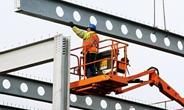Steel Markets

AGC Urges Changes to Tax Reform Bill to Sustain Construction Growth
Written by Sandy Williams
November 29, 2017
Construction employment increased in 243 out of 358 metro areas between October 2016 and October 2017, declined in 59 and stagnated in 56, according to a new analysis of federal employment data released by the Associated General Contractors of America.
“Growing demand, especially from the private sector, is continuing to drive construction employment gains in many parts of the country,” said Ken Simonson, the association’s chief economist. “The tax reform proposals now being debated in Washington can do even more to help ensure that metro areas will continue to add new construction jobs.”
Association officials said there was still time to improve the tax reform measure, noting that Senators have an opportunity to make improvements to the proposal. In particular, they urged Senators to set the final tax rate for pass-through businesses at a comparable level to the rate for corporations. And they urged Senators to boost infrastructure funding.
“Lowering the tax burden on many small and medium-sized employers and including new infrastructure funding will bring immediate and widespread benefits to local economies across the country,” said Stephen E. Sandherr, the association’s chief executive officer. “That is why the construction employers and workers our association represents are committed to helping ensure any final tax reform measure actually helps support continued construction job growth.”
Riverside-San Bernardino-Ontario, Calif., added the most construction jobs during the past year (14,700 jobs, 15 percent), followed by Las Vegas-Henderson-Paradise, Nev. (10,500 jobs, 18 percent); New York City, N.Y. (10,100 jobs, 7 percent); Portland-Vancouver-Hillsboro, Ore.-Wash. (8,000 jobs, 12 percent) and Los Angeles-Long Beach-Glendale, Calif. (7,500 jobs, 6 percent). The largest percentage gains occurred in the Cheyenne, Wyo., metro area (24 percent, 800 jobs) followed by Las Vegas; Killeen-Temple, Texas (16 percent, 1,600 jobs); and Lake Charles, La. (16 percent, 3,600 jobs).
The largest job losses from October 2016 to October 2017 were in Houston-The Woodlands-Sugar Land, Texas (-7,900 jobs, -4 percent), followed by Columbia, S.C. (-3,100 jobs, -18 percent); Kansas City, Mo. (-3,000 jobs, -11 percent); Middlesex-Monmouth-Ocean, N.J. (-2,300 jobs, -6 percent) and San Jose-Sunnyvale-Santa Clara, Calif. (-2,100 jobs, -4 percent). The largest percentage decreases for the year were in Grand Forks, N.D.-Minn. (-25 percent, -1,200 jobs) followed by Columbia, S.C.; Eau Claire, Wis. (-11 percent, -400 jobs) and Kansas City, Mo. (-11 percent, -3,000 jobs).

Sandy Williams
Read more from Sandy WilliamsLatest in Steel Markets

CMC looks beyond Arizona micro-mill woes to long-term viability of construction mart
Despite the economic and geopolitical upheaval of the last five years, CMC President and CEO Peter Matt points out that the construction market has been an essential element of the way forward.

US importers face stricter rules under revamped S232 tariffs
“CBP expects full compliance from the trade community for accurate reporting and payment of the additional duties. CBP will take enforcement action on non-compliance," the agency said in a March 7 bulletin.

Steel exports rebound in January
US steel exports recovered to a five-month high in January after having fallen to a two-year low in December. This growth follows four consecutive months of declining exports.

Construction spending drops marginally in January
Construction spending edged down slightly in January, slipping for the first time in four months. The US Census Bureau estimated spending at a seasonally adjusted annual rate of $2,196 billion in January, down 0.2% from December’s downward revised rate. The January figure is 3.3% higher than a year ago. January’s result, despite the slight erosion, […]

HVAC equipment shipments slow in December but strong annually
Shipments of heating and cooling equipment in the US fell to an 11-month low in December, according to the latest data released by the Air-Conditioning, Heating, and Refrigeration Institute (AHRI).
